#anglo-saxon norse and celtic
Explore tagged Tumblr posts
Text



Folks are loving the illuminated Beowulf book! Available now through my Etsy shop:
#medieval#illumination#calligraphy#celtic art#celtic#knotwork#leatherbound#norse#viking#irish#beowulf#anglo saxon#monsters#book art#heroes#fantasy
32 notes
·
View notes
Text
I had two days of from work and managed to visit my local Gallo-Roman museum (the name is actually deceiving as they focus on the area between Neanderthals and Merovingians). Here are some of the things I saw!
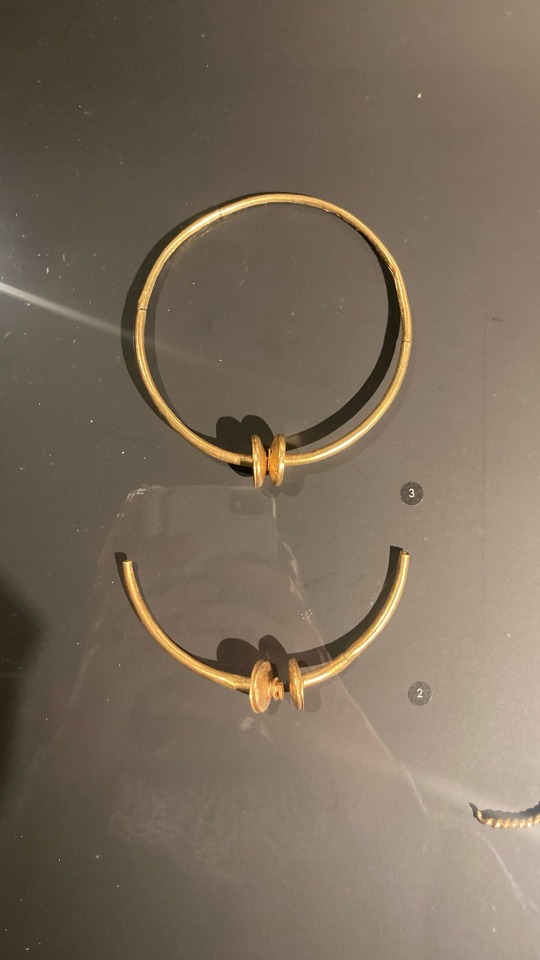





1) Gallic Torcs in gold
2) a complete Dodecahedron in bronze
3) Late Roman dress pins in bronze
4) Lunulae, moon shaped pendants, generally believed to be a lucky charm
5) a Merovingian bucket, a funerary gift
6) late Roman keys in iron
#frankish#merovingian#viking archaeology#archaeology#carolingian#charlemagne#field archaeology#viking mythology#merovingian archaeology#germanic mythology#roman archaeology#rome#ancient rome#western Roman Empire#ravenna#Gaul#gaulois#Celtic#Hallstatt#norse mythology#anglo saxon#viking#field archaeologist#frisian#odin#vikings#germanic#germanic folklore#germanic archaeology
20 notes
·
View notes
Text
Hello all and blessed be <3
I'm a closeted pagan, amateur herbalist and a novice folk/ hedge witch two years into my practice as I write this. I'm studying all Celtic, Anglo-Saxon, Appalachian and Norse witchcraft or folk practice. So I wanted to share my journey and knowledge somewhere, hence why I'm here.
I may not post consistently but I am going to post when I think of it. I'll be sharing anything from spirit, fair folk and deity work. Spells, folklore I've discovered or herbalism recipes. Just generally sharing my witchy and pagan journey somewhere.
#witch blog#witchy shit#hedge witch#pagan#witch stuff#grimoire#witchy vibes#witch aesthetic#celtic#ancient celts#anglo saxon#folklore#folk witchcraft#paganism#pagan witch#witchcraft#norse paganism#norse gods#norse mythology#norse runes#deity work#deity worship#herbalism#herbalist#foraging#faerie#cauldron#witches
16 notes
·
View notes
Text
If there's one good thing about Britain it's the diversity of its pagan past more than anything, and the fact that there's still so much to be found and rediscovered. Before Christianity, the land was home to countless pagan gods from numerous different cultural backgrounds. This includes not only Celtic, Brythonic, or later Anglo-Saxon gods, but also Roman gods and the gods of any number of foreign cults that came to Britain during the Roman era, as well as the Norse gods who were still worshipped by Vikings some time after Britain became Christian.
I guess the main virtue of that is that any number of gods have a place here.
#britain#british paganism#roman polytheism#norse polytheism#anglo-saxon polytheism#celtic polytheism#brythonic polytheism#paganism#pluralism
43 notes
·
View notes
Text

This book, The Real Middle Earth by Brian Bates has changed my life and my worldview so much holy moly, I feel like I am coming home, it all feels very familiar yet oddly uncanny.
Anyway I am diving back into my spirituality and sometimes getting a fresh perspective can really help- I had such narrow views of Paganism, Norse and Witchcraft and I rejected like my entire ancestral culture because of these perceptions, wholly put onto me by generation upon generation of Christianity.
I came to witchblr to find my own oath away from Christianity while perpetuating the same stereotypes and judgement that Christians back then believed. So closed minded.
Anyway I am starting over with real knowledge, with true understanding of the history and my ancestors and I feel so less burdened and carry absolutely zero shame or guilt around my spiritual practice because I have absolutely nothing to be ashamed of, Christianity and the Roman empire literally appropriated everything from my ancestors: took over Wells, exorcised trees and then built churchyards around them so that it belonged to them.. The list goes on.
anyway I'm reconnecting with my truth which is to be in rhythm with nature and respect and honour her in every way I can through my practices.
Nature is God. 🌳
#personal#mine#me#Norse#Celtic#Anglo-Saxon#witch community#paganism#paganblr#pagan witch#witchcraft#Real Middle Earth#The dark ages#Dark ages#Nature is God#Nature witch#Green witch#Spirituality#spiritualism#my ancestors#mother earth#Me
7 notes
·
View notes
Text
Spring Equinox Masterpost- Spoonie Witch Friendly
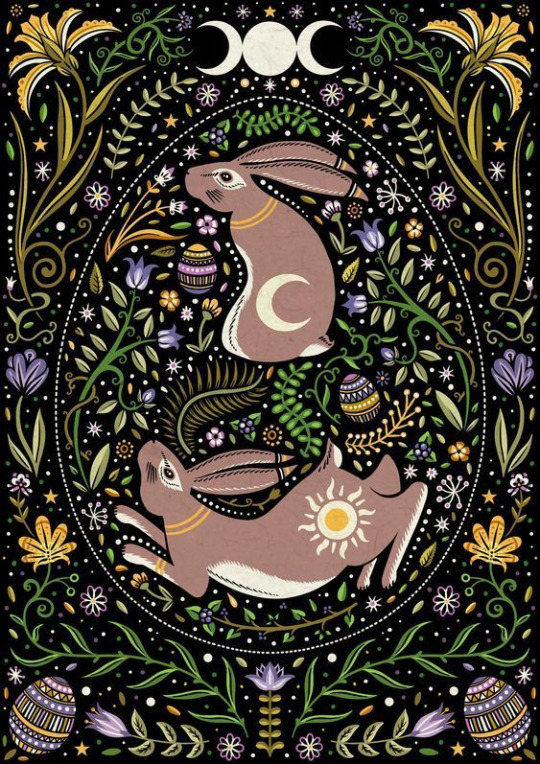
Art Credit: Anastasia Catris
The Spring Equinox, also called the Vernal Equinox or Ostara, is usually celebrated between the 21st of March in the Northern Hemisphere (In the Southern Hemisphere around September 20th or 21st)
In 2024, Ostara and the Spring Equinox land in the Northern Hemisphere on Monday, March 19th.
The Spring Equinox celebrates the arrival of spring. Celebrating balance, growth, and new beginnings as Winter has finally ended.
Spring Equinox Correspondances
Colours
Light Green
Lavender
Sunny Yellow
Light Blue
Pastel Pink
White
Herbal
Lemongrass
Daffodils
Tulips
Violets
Apple Tree
Cherry Blossom
Primrose
Birch tree
Hyacinths
Dandelion
Garlic
Ash tree
Jasmine
Edibles
Honey
Salad greens
Spring veggies
Fresh berries
Mead
Herbs
Eggs
Seeds
Bread
Edible flowers
Quiches
Custards
Maple
Animals
Hares
Baby Chicks
Snakes
Robins
Bees
Butterflies
Phoenix
Ram
Crystals
Fluorite
Moonstone
Silver
Aquamarine
Clear Quartz
Amazonite
Symbols
Bonfires
Flowers
Rabbits
Eggs
Seeds
Baskets
Flowering or Tree Buds
Lambs
Birds
Spiritual meanings
Purification
Cleansing (removal of stagnant energy)
Growth
Transition
Motivation
Balance
Birth
Good fortune
Kindness
Joy
Fertility
Scents
Coconut
Citrus
Floral scents (rose, lilac, jasmine, etc)
Herbal scents (rosemary, basil, mint, etc)
Gods / Goddesses / Spirits
Eostre – (Anglo-Saxon)
Aphrodite - (Greek)
Gaia - (Celtic)
Gaea - (Greek)
Venus - (Roman)
Athena - (Greek)
Aurora - (Roman)
Eos - (Greek)
Isis – (Egyptian)
Freya - (Norse)
Persephone - (greek)
Cybele - (Roman)
The Green Man - (Celtic)
Odin – (Norse)
Osiris – (Egyptian)
Pan – (Greek)
Thoth – (Egyptian)
Adonis – (Greek)
Apollon – (Greek)
Apollo - (Roman)
Need some suggestions to celebrate? I've got you covered.
High energy celebrations and ritual
Deep cleaning of the hearth and home
Nature hikes
Visiting farmers markets
Making preserves
Create a fae garden
Create a seasonal altar
Abundance/Prosperity ritual
New beginnings ritual
Low energy celebrations
Wear pastels
Create flower crowns
Light a candle with scent correspondence
No spoon celebrations
Opening a window
Journaling Prompts
Keeping hydrated
Drink floral tea
Rest
How you celebrate the holiday does not matter. You can choose to do any activity that feels right. These are only suggestions and remember that you're enough no matter what.
Also please note some stuff is UPG. A great book is Year of the Witch by Temperance Alden for honouring the celebrations and if you wanted to work more seasonally. It's not Wiccan-based and has plenty of resources for every witch.
Feel free to post how you celebrate in the comments or reblogs!
Want to see more of my posts? Check out my Wheel of the Year Masterpost or my Main Masterpost.
#witchcraft#witch#electic witch#witchblr#paganism#spoonie witch#spoonie magic#ostara#wheel of the year#witchy#spring equinox#seasonal magic#ostara masterpost#ostara correspondences#spring equinox masterpost#spring equinox correspondances#spoonie#chronic illness magic#chronic illness
1K notes
·
View notes
Text
I hope I can express this properly and sensitively, but I think oftentimes people need to have Categories and Identities and to be healthily exploratory and playful and elastic about them, else they can get vulnerable to some negative things, sometimes really awful things
I wish I could remember where I read it, but there was something that wrote about whiteness in America as an abyss.
Whiteness is something that sheltered white Americans' ancestors, and at the same time devoured them. They used to have a distinct medley of heritages: Irish, German, Scottish, Italian. "Whiteness" ate it up, the languages, the cultures. There were privileges if you destroyed it, and punishments if you held onto anything that was "Other." In a white supremacist society, white people wanted to be "white" first before any other possible identity or connection they could have.
Yay! You're white. You're on top. You win...what? Turns out the prize for "winning" is just that you get to perpetrate the violence of the game instead of being on the receiving end of it.
And that's the nasty twist—there is no prize. The deeply embedded vice of "Southern pride" is not just what the Confederate flag stands for, but also why they've got to cling so hard to that symbol of traitors and losers: they need to be on top of something so bad that even a pile of shit will do. My ancestors were ultimately dirt poor, loads of them ending up in prison or breaking their bodies down doing hard labor, but they were white. Their reward, and their pride, was being stepped on by the violence of poverty only, instead of also by the violence of white supremacy.
"White pride" is all about hate because white supremacy didn't give these folks anything to be proud of. It stripped away the culture and heritage their ancestors had in favor of "whiteness." All those jokes about how white people have no culture, well, it's true isn't it? This shit is how we ended up a primarily monolingual nation. And what looks like happened is that white Americans wound up just...scavenging most of their culture from those they oppressed. Food, music, all of that stuff. Our white ancestors didn't GIVE us anything that was their own to start with.
And this is something that really strikes me about the white supremacist and fascist movements nowadays: the starvation and hollowness behind them. These folks are empty inside. They were given nothing by white supremacy except a very vague sense that they deserve something, and they see people of all different cultures celebrating and flourishing in their unique heritages and identities, and they feel like...they've been cheated.
Equality is so threatening when you're in this situation because it feels like you've got less than everyone else at the end of the day. Not just because of comparison to previous privileges, but because your whole identity was "person that gets to step on everybody else" and your whole inheritance was "shit stolen from everybody else" and in a world where all is set right, you have no identity and nothing. You are nothing.
Anyway I was looking just now at a blog that seemed really white-supremacist-leaning and it was 99% about like, Norse and Proto-Indo-European paganism and "traditionalism" and that's what got me thinking about this again.
This person had apparently done DNA tests on themselves or something, and were really fixated on figuring out their Norse and Germanic ancestors and separating out their genetic and racial identity at a level of precision that seems really pointless that far back in time. And honestly all the paganism stuff seemed like totally arbitrary speculation as well.
And how to become satisfied as a person like this? I am just as much Germanic or Norse as they are, but I don't believe that distant ancestors determine who you are to such an extent that I have some sort of innate cultural tie to Vikings or Visigoths or what have you. I know what percentage Celtic or Anglo Saxon or Norse I am—zero. I learned about those things in books the exact same way I learned about all the cultures and past kingdoms of the world that I presumably don't have ancestors from.
I feel like the experience of being a baby ally and obsessing about apologizing for being white is the same kind of thing in another direction, or another outcome of the same process. Some people seem to get really twisted up for a time over how to stop being guilty about being white.
It's part of the same thing as this guy who is trying to genetically identify his ancestors from like 3,000 years ago. It's the emptiness and meaninglessness of "white" identity apart from white supremacy.
I talk about deradicalization sometimes and I've had the notion a few times that fascism appeals to people who are hollow and starving in terms of identity, and if it wasn't for the sense of emptiness and hunger, they would be less easily radicalized. But it's also a little bit awkward to talk about the deeply unsatisfying nature of white supremacy, because...well, that is pretty low on the list of things bad about white supremacy.
I think this concept is worth talking about in general, though: People want to feel like they come from or are part of something meaningful. They are drawn toward Identities and Categories and Belonging to groups. This is something I think is commonly true about humans, I think it is normal and not a bad thing, and I think we could stand to be a little more upfront about its reality.
I think this means that wanting, and seeking, a sense of cultural identity as a white person (particularly an American) needs to have some kind of non-horrible outlet for it. Because right now, it's nothing but a way to get radicalized, and the dominant other option people take (becoming the Guilty White Person) is liked by no one and helps nothing.
And maybe it doesn't need to have anything to do with race or culture or your ancestors or any of these things that can lead a person down such terrible paths. Maybe more of us should be furries!
As just another thing to consider, I'm reading the book Ecology of a Cracker Childhood and the author of the book uses the word "cracker" not like, with the gravity of reclaiming a "slur" or something like that, but seemingly because that is just the word she most strongly identifies with, the word that best articulates who "her people" are. This feels very solid and levelheaded to me, something that comes from someone with a good sense of themselves.
Personally I've thought a long time that more people should reclaim "redneck." Not in the sense of reclaiming a slur exactly, but in the sense of putting it in neutral usage among the folks it always referred to, instead of letting it increasingly be associated with any Southerner (regardless of working class background) that is the sort to wave a Confederate flag around. The very idea of gatekeeping "redneck" away from racists is just absolutely hilarious to me, I won't lie.
#random#identity#whiteness#i doubt anyone asked for an essay from a white southerner about race#but this is just what im thinking about tonight
2K notes
·
View notes
Text
List of interesting ressources pertaining to norse paganism, scandinavian folklore and history, and nordic religions in general
These are sources I have personally used in the context of my research, and which I've enjoyed and found useful. Please don’t mind if I missed this or that ressource, as for this post, I focused solely on my own preferences when it comes to research. I may add on to this list via reblog if other interesting sources come to my mind after this has been posted. Good luck on your research! And as always, my question box is open if you have any questions pertaining to my experiences and thoughts on paganism.
Mythology
The Viking Spirit: An Introduction to Norse Mythology and Religion
Dictionnary of Northern Mythology
The Prose and Poetic Eddas (online)
Grottasöngr: The Song of Grotti (online)
The Poetic Edda: Stories of the Norse Gods and Heroes
The Wanderer's Hávamál
The Song of Beowulf
Rauðúlfs Þáttr
The Penguin Book of Norse Myths: Gods of the Vikings (Kevin Crossley-Holland's are my favorite retellings)
Myths of the Norsemen From the Eddas and the Sagas (online) A source that's as old as the world, but still very complete and an interesting read.
The Elder Eddas of Saemung Sigfusson
Pocket Hávamál
Myths of the Pagan North: Gods of the Norsemen
Lore of the Vanir: A Brief Overview of the Vanir Gods
Anglo-Saxon and Norse Poems
Gods of the Ancient Northmen
Gods of the Ancient Northmen (online)
Two Icelandic Stories: Hreiðars Þáttr and Orms Þáttr
Two Icelandic Stories: Hreiðars Þáttr and Orms Þáttr (online)
Sagas
Two Sagas of Mythical Heroes: Hervor and Heidrek & Hrólf Kraki and His Champions (compiling the Hervarar saga ok Heiðreks and the Hrólfs saga kraka)
Icelandic Saga Database (website)
The Saga of the Jómsvíkings
The Heimskringla or the Chronicle of the Kings of Norway (online)
Stories and Ballads of the Far Past: Icelandic and Faroese
Heimskringla: History of the Kings of Norway
The Saga of the Volsungs: With the Saga of Ragnar Lothbrok
The Saga of the Volsungs (online) Interesting analysis, but this is another pretty old source.
The Story of the Volsungs (online) Morris and Magnusson translation
The Vinland Sagas
Hákon the Good's Saga (online)
History of religious practices
The Viking Way: Magic and Mind in Late Iron Age Scandinavia
Nordic Religions in the Viking Age
Agricola and Germania Tacitus' account of religion in nordic countries
Myths and Symbols in Pagan Europe: Early Scandinavian and Celtic Religions
Tacitus on Germany (online)
Scandinavia and the Viking Age
Viking Age Iceland
Landnámabók: Book of the Settlement of Iceland (online)
The Age of the Vikings
Gesta Danorum: The Danish History (Books I-IX)
The Sea Wolves: a History of the Vikings
The Viking World
Guta Lag: The Law of the Gotlanders (online)
The Pre-Christian Religions of the North This is a four-volume series I haven't read yet, but that I wish to acquire soon! It's the next research read I have planned.
Old Norse Folklore: Tradition, Innovation, and Performance in Medieval Scandinavia
Children of Ash and Elm: A History of the Vikings
The Penguin Historical Atlas of the Vikings by John Haywood
Landnámabók: Viking Settlers and Their Customs in Iceland
Nordic Tales: Folktales from Norway, Sweden, Finland, Iceland and Denmark For a little literary break from all the serious research! The stories are told in a way that can sometimes get repetitive, but it makes it easier to notice recurring patterns and themes within Scandinavian oral tradition.
Old Norse-Icelandic Literature: A Short Introduction
Saga Form, Oral Prehistory, and the Icelandic Social Context
An Early Meal: A Viking Age Cookbook and Culinary Oddyssey
Runes & Old Norse language
Uppland region runestones and their translations
Viking Language 1: Learn Old Norse, Runes, and Icelandic Sagas and Viking Language 2: The Old Norse Reader
Catalogue of the Manks Crosses with Runic Inscriptions
Old Norse - Old Icelandic: Concise Introduction to the Language of the Sagas
A Companion to Old Norse-Icelandic Literature and Culture
Nordic Runes: Understanding, Casting, and Interpreting the Ancient Viking Oracle
YouTube channels
Ocean Keltoi
Arith Härger
Old Halfdan
Jackson Crawford
Wolf the Red
Sigurboði Grétarsson
Grimfrost
(Reminder! The channel "The Wisdom of Odin", aka Jacob Toddson, is a known supporter of pseudo scientific theories and of the AFA, a folkist and white-supremacist organization, and he's been known to hold cult-like, dangerous rituals, as well as to use his UPG as truth and to ask for his followers to provide money for his building some kind of "real life viking hall", as supposedly asked to him by Óðinn himself. A source to avoid. But more on that here.)
Websites
The Troth
Norse Mythology for Smart People
Voluspa.org
Icelandic Saga Database
Skaldic Project
Life in Norway This is more of a tourist's ressources, but I find they publish loads of fascinating articles pertaining to Norway's history and its traditions.
#ressources#masterpost#heathenry#research#sources#norse paganism#norse gods#spirituality#polytheism#deity work#pagan#paganism#deities#norse polytheism#mythology#eddas#sagas
658 notes
·
View notes
Text
Medieval Names for male
Alaric: German for "ruler of all."
Aldous: Italian and German for "old, wealthy."
Archibald: German for "genuine, bold, brave."
Arne: Old Norse for "eagle."
Arthur: Celtic for "bear; strong man.""
Bahram: Persian for "victorious."
Bard: Gaelic for "poet" or "singer."
Bartholomew: Hebrew for "son of furrow” or "son of Ptolemy."
Benedict: Latin for "blessed."
Bertram: German and French for "bright raven."
Björn: German and Scandinavian for "bold as a bear."
Burchard: English for "strong as a castle."
Cassian: Latin for "vain."
Cathasach: Gaelic for "brave."
Charibert: German for "glorious warrior."
Conrad: Old German for "brave counsel."
Crispin: Latin for "curly."
Cyprian: Greek origin name that means "man of Cyprus."
Daegal: An Anglo-Saxon name with Scandinavian roots that means "dweller by the dark stream."
Drogo: Old German name for "to bear" or "to carry."
Drustan: Believed to be derived from the Celtic and Gaelic word "drest" which means "riot."
Dustin: Old English for "dark stone" and German for "valiant fighter." It also means Thor’s stone.
Elric: English for "wise ruler."
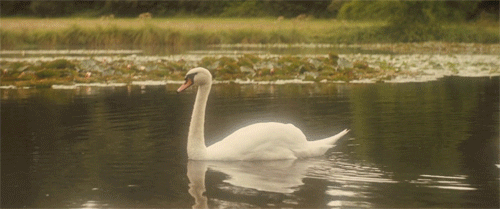
#writerscommunity#writer things#writers#writeblr#on writing#writblr#writers on tumblr#creative writing#writing#writersociety#write#writings#writers and poets#writer#women writers#ao3 writer#amwriting#writers community#writing community#writers life#writers block#female writers#writer stuff#writer problems#fanfiction writer#fanfic writer#writer community#writer on tumblr#writers of tumblr#writers on ao3
218 notes
·
View notes
Text
Every Pagan Holiday
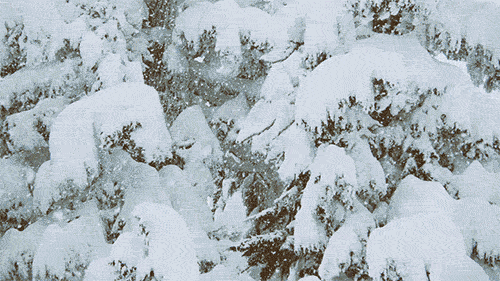
JANUARY
KALENDS
1st January
Origins: Ancient Greece/Rome
Observed by: Hellenic/Roman polytheists
Honouring Janus/Juno, first day of the Year. Kalends brought us the word 'calendar'.
ÞORRABLÓT (THORRABLÓT)
End of January/beginning of February
Origins: Iceland
Observed by: Heathens, Asatru
Midwinter Festival honouring Thor, usually by feasting and poetry.

FEBRUARY
IMBOLC
2nd February
Origins: Celtic polytheism /Ireland, as St. Brigid's Day
Observed by: Most neopagans, Wiccans, Druids, Asatru (as Charming of the Plow)
Imbolc is the most widely known and observed pagan holiday in the months of January and February. It falls at the beginning of spring/end of the winter for the Celtic peoples; marking the changing of the seasons, as most holidays do. St. Brigid is a Christianised form of or inspired by the Celtic fertility goddess Brigid who is celebrated on this day.
PARENTALIA
13th-21st February
Origins: Ancient Rome
Observed by: Greco-Roman polytheists
Translating to 'Ancestors Day', Parentalia is a nine-day celebration of deceased ancestors. Historically it was observed by feasting and making offerings and sacrifices to the dead and spirits of the underworld.
VÁLI'S BLOT
14th February
Origins: Old Norse
Observed by: Heathens, Asatru, Norse polytheists
Váli's Blot is considered by some Asatru to be the Norse equivalent of Valentine's Day but is widely acknowledged as a season changing festival. A day for marriage and celebrating with family and friends, and for remembrance of Váli, the son of Odin who defeated Höðr on this day.
LUPERCALIA
15th February
Origins: Ancient Rome
Observed by: Greco-Roman polytheists
Festival thought to honour a wolf who raised abandoned princes, celebrated originally by sacrificing goats to the gods, feasting, and, for fertility, nudity and fornication.
LESSER ELEUSINIAN MYSTERIES
17th-23rd February
Origins: Ancient Greece
Observed by: Hellenic polytheists
Initiation to the cult of Persephone and Demeter by sacrificing a pig. Prelude to Greater Mysteries, initiations held on these dates. Once completed, initiates could then move onto Greater Mysteries in the autumn.
ANTHESTERIA
27th February - 1st March 2021
Origins: Ancient Greece
Observed by: Hellenic polytheists
Athenian festivals dedicated to Dionysus and the dead. Held around the full moon in the month of Anthesterion, which in the Gregorian calendar this year roughly translates to 27th February.
THE DISTING/DÍSABLÓT
End of February/beginning of March
Origins: Uppsala, Sweden
Observed by: Heathens, Asatru, Norse polytheists
Celebration of Valkyries and other female spirits, called dísir. Sacrifices were made for a good harvest. Celebrated still by an annual market in Sweden.
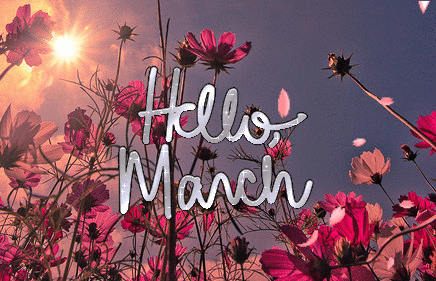
MARCH
KALENDS
1st March
Origins: Ancient Greece/Rome
Observed by: Hellenic/Roman polytheists
Honouring the god Mars/Ares. Kalends brought us the word 'calendar'.
OSTARA/EARRACH
20th March
Origins: Anglo Saxon paganism, popularised as Ostara by Wicca
Observed by: Anglo Saxon Pagans, Wiccans, Neopagans, Druids (as Alba Eilir), Heathens (as Summer Finding), Ásatrú (as Sigrblót)
The northern hemisphere's vernal equinox, the word Ostara was introduced though Wicca and named for the goddess Eostre. Surprisingly unrelated to Easter in all but name, Ostara symbolises the beginning of spring. As a seasonal holiday it is widely celebrated by many different groups of pagans.
RAGNAR LODBROK'S DAY
28th March
Origins: Icelandic Sagas
Observed by: Ásatrú
Day of remembrance for Ragnar Lodbrok, Viking King of legend

APRIL
KALENDS/VENERALIA
1st April
Origins: Ancient Greece/Rome
Observed by: Hellenic/Roman polytheists
Celebration of the first of the month, this one honouring the goddess, Venus.
REMEMBRANCE FOR HAAKON SIGURDSSON
9th April
Origins: Norway, C9th
Observed by: Ásatrú
Day of remembrance for ruler of Norway who claimed lineage to Odin in the Icelandic Sagas.
WALPURGISNACHT
30th April
Origins: German Christianity, originally Saint Walpurga was known for banishing witches and other pests
Observed by: LaVeyan Satanists
Anton LaVey chose to celebrate this holiday as a follow up to the spring equinox and due to its past association with witchcraft.
HEXENNACHT (WITCHES' NIGHT)
30th April
Origins: German folklore, as Walpurgisnacht but witches were alleged to convene with the devil in this night
Observed by: Temple of Satan as 'a solemn holiday to honour those who were victimized by superstition'.

MAY
BEALTAINE/BELTANE
1st May
Origins: Celtic (Ireland/Scotland/Isle of Man)
Observed by: Wiccans, Neopagans, Celtic reconstructionist, Ásatrú/Heathens (as May Day)
One of the more well-known pagan festivals, Beltane is a festival of fire and the beginning of the summer. Also widely referred to as May Day, it is celebrated by lighting fires.
KALENDS
1st May
Origins: Ancient Greece/Rome
Observed by: Hellenic/Roman polytheists
Honouring the goddess Maia, for whom the month may have been named.
REMEMBRANCE FOR Guðröðr of Guðbrandsdál
9th May
Origins: C11 Norway, Icelandic Sagas
Observed by: Ásatrú, Norse, heathens
Guðröðr had his tongue removed by Óláfr for rebelling against violent conversion from Norse paganism to Christianity.
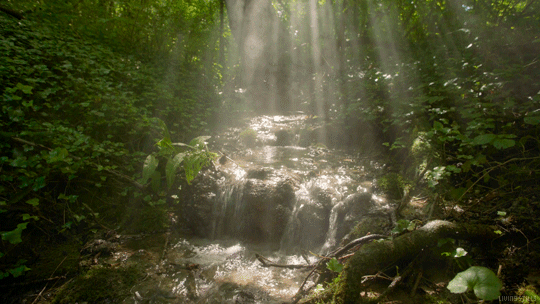
JUNE
KALENDS
1st June
Origins: Ancient Greece/Rome
Observed by: Hellenic/Roman polytheists
Anniversary of temples to Juno Moneta (protectress of money, her temple was where coins were made), Mars/Ares (God of war), and the Tempestates (goddesses of storms).
ARRHEPHORIA
3rd Skirophorion (translates to mid-June)
Origins: Ancient Greece
Observed by: Hellenic reconstructionist
Feast in celebration of Athena and fertility.
MIDSUMMER/SUMMER SOLSTICE
21st June
Origins: Agricultural holiday/longest day observed for centuries by many civilisations. Christianity can date to as early as C4th
Observed by: Wiccans/Germanic neopagans (as Litha), Asatru/Heathens, Druids (as Alban Hefin)
One of the main four holidays in the Wheel of the Year and popularised by Wiccans and neopagans as Litha which is taken from the Anglo-Saxon words for June/July, this is the longest day of the year and the middle point and sometimes considered the beginning of summer.

JULY
REMEMBRANCE FOR UNNR/AUD THE DEEP MINDED
9th July
Origins: C9th Iceland
Observed by: Ásatrú, Heathens, Norse reconstructionist
Aud was a traveller in the 9th century moving between Dublin, the Hebrides, Orkney, and finally Iceland following the deaths of her husband and son. This day is to honour her memory.
HERACLEIA
July/August
Origins: Ancient Greece
Observed by: Hellenic polytheists
Festival dedicated to Heracles the demigod and his death, involving feasting and celebration.
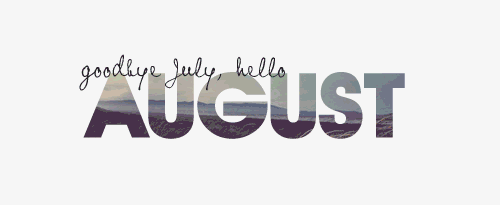
AUGUST
LUGHNASADH/LAMMAS
1st August
Origins: Celtic Britain (Ireland, Scotland, Isle of Man)
Observed by: Wiccans, Neopagans, Christians (as Lammas), Ásatrú (as Freyfaxi)
Named for the god Lugh, this festival is one of the Celtic harvest festivals and marks the beginning of the harvesting months. It was celebrated by climbing mountains, bull sacrifice, offerings, and feasting. Handfasting is commonplace with Wiccans in modern times.
REMEMBRANCE FOR REDBAD, KING OF THE FRISIANS
9th August
Origins: C7th Frisia (area of Germany/Netherlands)
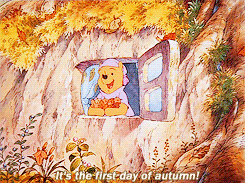
SEPTEMBER
NOUMENIA
8th September
Origins: Ancient Greece
Observed by: Hellenic polytheists
Celebration of new Hellenic lunar month. Offerings of honey and incense made to household deities.
REMEMBRANCE FOR HERMANN THE CHERUSCAN
9th September
Origins: C9th CE
Observed by: Heathens, Ásatrú
Hermann the Cheruscan, also known as Arminius of the Cherusci tribe, led the defeat against the Romans at the Battle of Teutoburg Forest and is lauded for saving Eastern Germanic peoples from being conquered by the Roman Empire.
AUTUMN EQUINOX (NORTHERN HEMISPHERE)
22nd September
Origins: 1970s neopaganism
Observed by: Wiccans and Neopagans (as Mabon), Ásatrú (as Winter Finding)
Named Mabon by prominent Wicca and Neopagan Aidan Kelly, after the Welsh mythological figure Mabon ap Moldron, the autumn equinox is one of the harvest festivals and marks the beginning of autumn in the northern hemisphere. Mabon is a relatively new pagan holiday not based on any specific historical festival, but traditionally people around the world would celebrate some kind of harvest festival around the end of September/beginning of October.
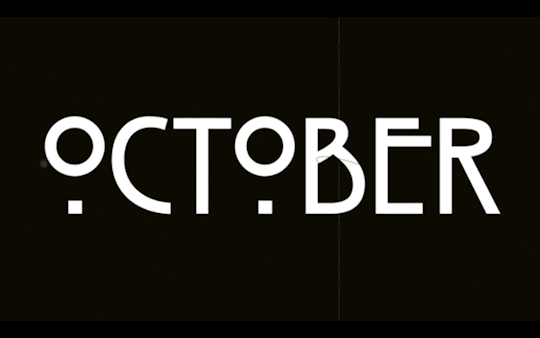
OCTOBER
PYANOPSIA
7th October
Origins: Ancient Greece
Observed by: Hellenic polytheists
Pyanopsia, or Pyanepsia, is a festival to honour Apollo, one of the most important deities, God of music, the sun, knowledge, healing, and archery - amongst other things. During the festival, two special offerings would be placed on doorways and carried to the temple. These offerings were a bean stew, and an olive branch wrapped in wool with honeys, pastries and seasonal fruits hanging from it.
REMEMBRANCE FOR LEIF EIRIKSSON
9th October
Origins: C10th CE
Observed by: Heathens, Ásatrú, Norse pagans
Remembrance for Leif and his sister Freydís Eiríksdóttir, children of Erik the Red, who are cited with being the first Norse explorers in North America.
THESMOPHORIA
12th-14th October
Origins: Ancient Greece
Observed by: Hellenic polytheists
Festival held in honour of Demeter Thesmophoros, goddess of agriculture, and her daughter Persephone, goddess of death and life, Queen of the Underworld. Celebrated primarily by women, this festival is linked with fertility, and we know very little about it due to its secretive rites. It is thought that it involved the sacrifice of pigs (although some sources say women), and abstinence.
REMEMBRANCE FOR ERIK THE RED
28th October
Origins: C9th CE
Observed by: Heathens, Ásatrú, Norse pagans
Erik the Red, probably named for the colour of his hair and beard, was the first permanent European settler in Greenland. His children were explorers too, who went to America, and although his wife converted to Christianity, Erik remained faithful to his Norse pagan gods.
SAMHAIN (HALLOWE'EN)
31st October-1st November
Origins: Gaelic - Scotland, Ireland, Isle of Man
Observed by: Celtic pagans, Neopagans, Wiccans
Pronounced SOW-in (sow rhyming with cow), Samhain was originally a harvest festival marking the beginning of winter. The day itself is the 1st November, but celebrations begin on October 31st, and this has become the accepted associated day. It's a festival of the dead, where the síthe, fae and spirits, can enter this realm from their own. Wiccans talk of a 'veil' thinning, meaning the boundary between worlds. Similar death related festivals around this time can be noted in other faiths from across the globe, and of course in the modern Hallowe'en.
WINTER NIGHTS (VETRNAETR), ÁLFABLÓT/DÍSABLÓT
31st October
Origins:
Celebrated by: Heathens, Ásatrú, Norse pagans
Winter Nights is mentioned in the Ynglinga Saga as one of the three greatest blessings of the year, the other two being Sigrblót in April, and þorrablót in late Jan/early Feb. Winter Nights is the celebration of the beginning of the winter season; Álfablót is a sacrifice to the elves, and Dísablót a sacrifice to the female spirits (dísir) and Valkyries.
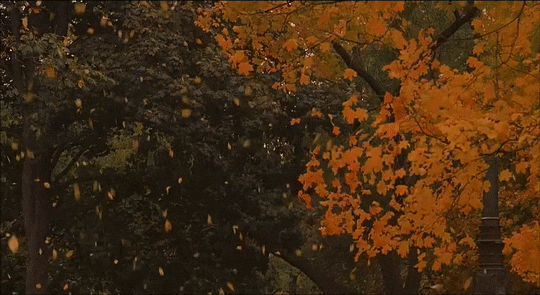
NOVEMBER
REMEMBRANCE FOR SIGRID THE HAUGHTY
9th November
Origins: C9th CE
Observed by: Heathens, Ásatrú, Norse pagans
It is not actually known whether Sigrid Storråda, or Sigrid the Haughty, was an actual historical figure, an amalgamation of a few, or simply a myth. The lore goes that she was proposed to multiple times and turned down many but went on to orchestrate conflict when a potential suitor - Olaf Tryggvason, King of Norway - attempted to convert her to Christianity.
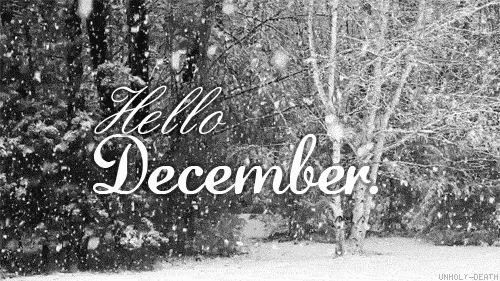
DECEMBER
REMEMBRANCE FOR EGILL SKALLAGRÍMSSON
9th December
Origins: C10th CE
Observed by: Heathens, Ásatrú, Norse pagans
Day celebrating the poet, farmer, and berserker Egill Skallagrímsson, who is recalled in The Icelandic Sagas by Snorri Sturluson. Egill is known for his many killings and escaping death by writing an epic poem after being captured when washing up on our Northumberland coastline.
SATURNALIA
17th - 23rd December
Origins: Ancient Rome
Observed by: Roman polytheists, some Hellenic
Like Yule and Lesser Dionysia, Saturnalia was the Roman winter festival celebrating the coming return of the sun and honouring the god Saturn. The standard feasting and drinking feature, and slaves would be treated as equals like Dionysia. Saturnalia is another festival cited as being picked up by Christians and used as inspiration for Christmas.
WINTER SOLSTICE (YULE/MIDWINTER)
21st December
Origins: Germanic nations, as early as C4th CE
Observed by: Norse pagans, Wiccans, Neopagans, LaVeyan Satanists, Ásatrú, Heathens, many Germanic nonpagan peoples
Yule is the midwinter festival known commonly among pagans as a time for feasting, being with loved ones, remembering ancestors, and looking forward to the return of the light and warmer days. Many pagans will celebrate Yule for more than one day, some celebrating a week either side, some for longer, up to two months, and some for twelve days afterwards. True Yule would have originally been in January for midwinter, but King Haakon the Good
moved it to coincide with the Christian celebrations in the 10th century, as told in the Ynglinga Saga.
On the 24th of December, Anglo Saxons are said to have celebrated 'Mothers Night' honouring female ancestors.
RURAL/LESSER DIONYSIA
End of December/beginning of January
Origins: Ancient Greece
Observed by: Hellenic polytheists
Smaller festival honouring the god Dionysus (Greater Dionysia took place in cities at the end of winter). Feasting, mask wearing to stop distinction between classes so that everyone could feel equal, sacrifices, parades, and phallic display were all used to celebrate.
#wheel of the year#wiccan#pagan#heathen#greek#mythology#holidays#religious holidays#pagan holidays#non-Abrahamic holidays#witch#witchcraft#witchblr#pagan wicca#polytheism#paganism#witches#witch holidays#witches holidays#pagan witch
254 notes
·
View notes
Text
Germanic Paganism Resource Masterlist
Notes: - Updates will be beyond infrequent. - Feel free to pop into my ask box requesting resource recommendations at any moment. - Resources do not reflect my personal beliefs or practice. I may include otherwise great resources that include theories and ideologies I do not support (such as the 'sign of the Hammer'), because I make extensive use of cross-referencing, reflection, etc to determine everything I incorporate into my craft. - I will never consciously add resources written by (Neo-)Nazis and the like. If you spot them, feel free to let me know. - You may notice there is a seemingly disproportionate amount of sources also or primarily talking about Scandinavia and Iceland, and even some primarily covering England. This is because continental Germanic paganism has only barely survived the ravages of time, and one can only learn about it if they supplement their knowledge with the more complete pictures of Anglo-Saxon paganism and Norse paganism.
Legend: [No language identifier means the source is English.] [D] - The resource is written (primarily) in Dutch. [G] - The resource is written (primarily) in German. [ON] - The resource is written (primarily) in Old Norse. [OD] - The resource is written (primarily) in Old Dutch. [OG] - The resource is written (primarily) in Old High German. [L] - The resource is written (primarily) in Latin. [F] - The resource is written (primarily) in French. * - I have not read the resource in its entirety. ** - Read with caution. !! - There is more of the resource available/this is one part of multiple.
Historic Texts and References
Tacitus' Agricola and Germania
Tacitus' Annals
The Prose Edda
The Poetic Edda
The First Nine Books of the Danish History of Saxo Grammaticus
Contemporary Books, Essays, Other Media
Myths and symbols in pagan Europe : early Scandinavian and Celtic religions - H.R. Ellis Davidson
Kleinere Altniederdeutsche Denkmälen - Heyne [G]*
Religion and Philosophy in Germany : a Fragment - Heine *
Deutsche Volkskunde - Adolf Bach [G]*
Teutonic Mythology - Grimm
Swedish Legends and Folk Tales - John Lindow
Scandinavian Mythology : an Annotated Bibliography - John Lindow *
Trolls : an Unnatural History - John Lindow
Myths of the Norsemen from the Eddas and Sagas - H.A. Guerber
Northern mythology : comprising the principal popular traditions and superstitions of Scandinavia, North Germany, and The Netherlands - Benjamin Thorpe | VOL 1, VOL 2, VOL 3
From Myth to Fiction : the Saga of Hadingus - Georges Dumézil *
The Stakes of the Warrior - Georges Dumézil **
Gods of the Ancient Norsemen - Georges Dumézil **
Zum Tamfana-Rätsel - Edmund Weber [G]*
De Tijdstippen van de Cultische Jaarfeesten - Boppo Grimmsma [D]**
Nederlansche Volksoverleveringen en Godenleer - Van den Bergh [D, OD]*
Tales and Legends of Tyrol *
Germanic Spirituality - Bil Linzie
Handwörterbuch des Deutschen Auberglaubens - Baechtold-Staubl, Hoffman-Krayer
Goden van de Lage Landen - Gunivortus Goos [D]**
Runic and Heroic Poems of the Old Teutonic Peoples - Dickins *
Gods and Myths of Northern Europe - H.R. Ellis Davidson
Old Norse - Icelandic Literature : a Critical Guide - John Lindow
Vikings : a Very Short Introduction - Richards *
Norse Mythology : a Guide to the Gods, Heroes, Rituals and Beliefs - John Lindow
Antwoord op de Vraag, door het Zeeuwse Genootschap de Wetenschappen - te Water [D]*
Verhandelingen over het Westland, ter opheldering der Loo-en, Woerden en Hoven, benevens de natuurdienst der Batavieren en Friezen - Buddingh [D]*
De Goden der Germanen - de Vries [D]*
Norse Revival: Transformations of Germanic Neopaganism - Stefanie von Schnurbein (in the series Studies in Critical Research on Religion which I highly recommend)
Digital Libraries, Dictionaries and the Like
Digitale Bibliotheek voor Nederlandse Letteren [D]*
Digitised Collection of Historic Sources of the WWU in Münster [G, D, OD, OG]*
Oudnederlands Woordenboek [D, OD]*
Ons volksleven : tijdschrift voor taal-, volks- en oudheidkunde. Jaargang 2-12 [D]*
Het Rad - Digitale Bibliotheek voor Germaans Heidendom, Runen, Seidr [D]*
Volkskunde (search results on Delpher) [D]*
Goden van Eigen Bodem - Digitale bibliotheek voor heidens erfgoed van de lage landen [D]*
Godinnen van Nederland en België [D]**!!
Forgotten Gods - Reginheim **
The Rune Poems *
Kronieken van de Westhoek (Flemish Folk History) [D]*
Brabantse Folklore, bulletin van de provinciale dienst voor geschiedkundige en folkloristische opzoekingen [D]*
Project Gutenberg has a wealth of resources about pre-christian Germanic religion*
Mimisbrunnr.info has a wealth of information including starter guides.
Author Recommendations
J.R.W. Sinninghe [D]
John Lindow
Benjamin Thorpe
H.R. Ellis Davidson
The Grimm Brothers
J. Haver [D]
To be continued.
54 notes
·
View notes
Text

Getting everything ready for launch next week! Check out the preview page, give it a follow, pass it around!
#medieval#illumination#calligraphy#leatherbound#celtic art#celtic#tolkien#norse#middle earth#knotwork#vikings#norse mythology#anglo saxon#english literature#books & libraries#books#book art#illustration
65 notes
·
View notes
Text
Boar helmets

Boar statuettes have been used as helmet decorations during the Germanic age both in mainland Europe, as well as Anglo-Saxon England and Vendel Scandinavia.
But could you have guessed that boars have been used as helmet decorations since Celtic times? More accurately I should say Hallstatt era Iron Age, but it does mean that the idea of warriors mirroring themselves with boars as fearless creatures in combat, has been in existence before the Roman conquest of Europe and has managed to survive up until the Christianization of all layers of society around 800-900 AD.
The helmet above is the “Benty Grange helmet”. Contrary to more famous helmets, is that this particular one was plated with horn rather than metal. The boar on top may have been decorated with hair running along its back. This was the first Anglo-Saxon helmet ever to be discovered, found in 1848.
Weston Park Museum - Sheffield, England
Museum nr. Unknown
Found at Benty Grange farm, Monyash - Derbyshire, England
#merovingian#frankish#carolingian#Merovingian archaeology#Frankish archaeology#Carolingian archaeology#vikings#Viking#Nordic#Norse#anglo saxon#Anglo Saxon archaeology#viking archaeology#norse mythology#germanic folklore#germanic mythology#nordic mythology#celtic#celtic mythology#celtic warrior#viking warrior#archaeology#field archaeology#viking mythology#charlemagne#frisian#helmet#warrior#boar#Roman
55 notes
·
View notes
Text
About Me, My Books, and My Research (2024 Edition)
Hi, I'm Finn, a writer, medievalist, and all-round nerd. You may know me as the author of The Butterfly Assassin, "that person who wrote the trans Cú Chulainn article", the weird nerd in the Tumblr corner writing excessively long and incomprehensibly niche posts about their research, or something else entirely. I am all of those things! (Well, depending on what the 'something else' is, anyway...)
Currently, I'm a PhD student at the University of Cambridge researching friendship in the late Ulster Cycle (c. 12th-17th centuries). I have an MA in Early and Medieval Irish from University College Cork, and wrote my thesis about Láeg mac Ríangabra, my best beloved. I also have an undergrad degree in Anglo-Saxon, Norse and Celtic from Cambridge, and wrote my dissertation about queer readings of Táin Bó Cúailnge, including transmasculine readings of Cú Chulainn.
You can find out more about my research on my website, which also includes info about all of my academic publications. This includes the aforementioned "trans Cú Chulainn article", an article about Láeg in the Death of Cú Chulainn, an article about the seven Maines, and a discussion of a conference on Caoineadh Airt Uí Laoghaire from the perspective of my own work on lament and grief. Whenever possible, I try to make my research available Open Access. If you're ever having trouble finding one of my articles, please contact me!
If you want recommendations for books about medieval Irish (or Welsh) literature, this list on my Bookshop page has all my go-to recommendations. If you buy via this link, I earn a small commission at no extra cost to you, so this is a great way to support me.
I am also an author, and I write both YA and adult novels. Again, my website is the place to go for all the info and links, but a quick summary:
The Butterfly Assassin trilogy (The Butterfly Assassin, 2022; The Hummingbird Killer, 2023; Moth to a Flame, 2024): YA thrillers about a traumatised teenage assassin who is trying (and failing) to live a normal life in a fictional closed city in Yorkshire. Featuring friendship, street art, Esperanto, zero romance, and a whole lot of murder, as well as increasingly unsubtle commentary on the UK arms industry and the military recruitment of vulnerable teenagers.
The Wolf and His King (coming Spring 2025 from Gollancz): a queer retelling of 'Bisclavret' by Marie de France which uses werewolfism as a metaphor to explore chronic pain and illness. Also very much about yearning, exile, and the mortifying ordeal of being known.
The Animals We Became (coming 2026 from Gollancz): a queertrans retelling of the Fourth Branch of the Mabinogi looking at gender, compulsory heterosexuality, and trauma, through the medium of nonconsensual animal transformations.
To Run With The Hound (coming 2027 from Gollancz): my take on the Ulster Cycle, looking at why Táin Bó Cúailnge is a tragedy and what it means to be doomed by the narrative, but not in the way you thought you were. Featuring a lot of feelings about Cú Chulainn, Fer Diad, and Láeg.
You can find out more about my recently-announced medieval retellings in this blog post.
I generally tag personal posts and selfies as “#about the author”; other than that, I think I’m pretty straightforward with my tagging system.
I’m very happy to answer questions about medieval Irish lit, my research, or my books, or just generally to chat. Send questions via asks, chat via DMs, and if you're looking for my articles, you can email me at finn [at] finnlongman [dot] com, which is also the best way to contact me for professional enquiries, whether academic or fiction related.
You can also find me on Bluesky, on Instagram, and on YouTube, where I (infrequently) retell medieval Irish stories for a general audience with lots of sarcasm and hand gestures. Technically I'm still on Twitter, but I'm trying to leave.
And finally, if you’ve found my research interesting or just generally want to support me, I have a tip jar and am always immensely grateful when somebody helps me to fund my book-buying habits: http://ko-fi.com/fianaigecht. You can also tip me directly on Tumblr if you like. I’m also a Bookshop affiliate, and you can buy books from my recommendation lists to support me and get some great reads at the same time.
#about the author#the wolf and his king#to run with the hound#the butterfly assassin#also owls are transmasculine now#writing#books
74 notes
·
View notes
Note
Can you give an overview of your conworld and language for new people?
Absolutely! :D
The World
The setting I write in (hereafter "Boralverse") is an alternate history of Earth. The original difference from our own history (hereafter "IRL") is the existence of the island of Borland (Istr Boral) between Great Britain and Denmark, inspired by the IRL existence of Doggerland.

The human pre-classical history of Borland can be summarised as:
With sea level rise about 8k years ago, Borland was cut off from the continent and from Britain (this is when Doggerland was submerged IRL); some Stone Age people remain. They leave some monuments—burial mounds, the Çadrosc labyrinth—and were farmers, but they had no writing or ironworking.
The Celts arrive in Borland shortly before they settle Britain in the second millennium BCE, taking up iron tools and establishing many tribal groups. Due to some later migration from Britain to Borland, they speak a language (Borland Celtic) which is most closely related to Proto-Brythonic.
I assume that as far as possible the history of the rest of the world is indistinguishable from the IRL history up to this point. I continue to do so while the Romans invade and settle Borland shortly after Britain, despite conceding to credulity and allowing a few classical references:
...in Ptolemy's description of the Pritannoi we can understand he referred to the Insular Kelts of Ireland, Britain and Borland as a whole... ...contrasting Hadrian's policies in Britain and in Borland is vital for understanding their different fates in the post-Classical age...
where I admit that the Roman Empire having an entire additional province should probably have some observable effects.
Once the Western Roman Empire collapses, I start properly diverging Boralverse history from IRL history. This begins with a different pattern of Anglo-Saxon migration; the two petty kingdoms of Angland and Southbar arise in western Borland, while the settlement of England proceeds slightly slower than IRL.
Historical divergence spreads through western Europe over the next few centuries, and by 1000 CE things are beginning to go off the rails all across Eurasia and North Africa. I leave the history of the Americas the same until Old World contact (via Basque fishermen stumbling across Newfoundland in 1470 CE), and likewise with Australia.
The map below shows Europe in 1120, during the Second Tetrarchy Period. At this time, Europe was unusually centralised, with four great empires: the First Drengot Empire (red), the German Empire (brown), the Second Roman Empire (purple) and the Single Caliphate (green).
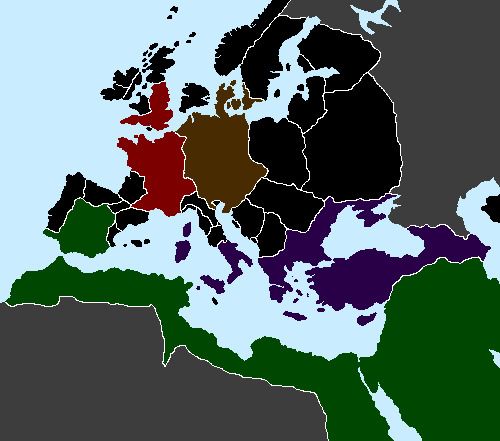
In the modern era, my hope is that the Boralverse world feels fractally uncanny; at every scale something is unexpectedly different, from political borders and languages to fashion and pop culture references.
For clarity, I employ an inconsistent Translation Convention when writing from a Boralverse perspective, mostly using IRL English but peppering in calques of Boralverse English jargon for flavour, such as threshold force "nuclear power" or jalick "garment socially equivalent to a tuxedo".
The Language
The original motivation for this alternate history setting is Borlish (Borallesc), the Romance language spoken on Borland.
It picked up a few Borland Celtic loanwords from the existing population at the time of the conquest (macquar ~ Welsh magu "raise, rear"; vrug ~ Welsh grug "heather"), but was much more influenced through the first millennium by Anglo-Saxon settlement and then Norse conquest during the Viking Age. The following is an example of late Old Borlish (ca. 1240):
…sovravnt il deft nostre saȝntaðesem eð atavalesem n iȝ atrevre golfhavn seȝ hamar dont y verb divin ismetre ac povre paian. peðiv soul ez font istovent por vn nov cliȝs d istroienz istablir… …uphold our most sacred and ancient duty to let Gulfhaven be the centre from which we will send the Word of God to pagan lands. We ask only for the necessary funds for a new teachinghouse…
The Modern Borlish language has undergone spelling standardisation (most recently deprecated some irregular spellings in 1870), and contains many more Latin and Greek loanwords, along with borrowings from languages across the world.
Y stal zajadau dy marcað nogtorn accis par lamp fumer eð y lun fragnt de mar receven cos equal party a domn pescour pevr jarras e fenogl gostant tan eð eç nobr robað n'ornament fluibond ant queldin raut frigsað ne papir cerous. The night market's various stalls lit by smoky lamps and the sea-shattered moon welcomed flocks of fishwives sampling paprika and fennel as well as notables in flowing finery carrying stir-fried suppers in wax papers.
In terms of sound changes and grammatical developments, the major points include:
Intervocalic lenition /p t k b d g/ > /v ð j ∅ ∅ ∅/: catēna > caðen "chain", dēbēre > deïr "must".
The use of ç (and c before e i y) for /ts/, and the use of g in coda to represent /j/. Along with some vowel shifts, this leads to things like cigl /tsajl/ "darling".
Total loss of final consonants in multisyllable words, including -s, which leads to:
Collapse of noun declension, including number; Borlish does not mark number on nouns, and if it wants to it uses demonstratives or simply relies of verb agreement: l'oc scuir pasc, l'ec scuir pascn "this boy eats, these boys eat".
57 notes
·
View notes
Text




The Hobbit and The Lord of The Rings - The Lord of the Ducks?! -Duckverse in June - Mystical Creatures - Cosplay and literature - Duck comics, Ducktales, Quack Pack, Darkwing Duck and Mighty Ducks - Duckverse - My version - Fantasy
Well, more specials related to Donald Duck's 90th birthday that I drew and related to one of my favorite topics, certainly related to fantasy, literary works and movies, and one of the best works in the world that is definitely worth reading, and it is Tolkien's works, The Hobbit and Lord of the Rings.
John Ronald Reuel Tolkien was an English writer and philologist (study of the origin of language) and one of the greatest fantasy writers of all time who will certainly influence other authors and future generations. Born in 1892, died in 1973. He translated Beowulf, one of the oldest surviving Anglo-Saxon epics, and also wrote The Silmarillion, The Hobbit, The Lord of the Rings, and other works. However, he was best known for The Hobbit and The Lord of the Rings. He inserted a lot into his works from Norse, Celtic, Slavic, ancient Greek and ancient Roman mythology, as well as elements from antiquity and the Middle Ages that happened in Europe, as well as religious elements, and of course he invented the Elvish language in his own way, and it is considered that that and high fantasy. The Hobbit was published in 1937, while The Lord of the Rings was written between 1937 and 1954, and published in 1954 and 1955 in three volumes, which are called "The Fellowship of the Ring", "The Two Towers" and "The Return of the King". Of course, it received a lot of film and animated adaptations, the most famous and popular of which are Ralph Bakshi from 1978, the version by Rankin-Bass from 1977 and 1980 The Hobbit and The Return of the King, and certainly the most famous that received the most Oscars are Peter Jackson's films with the same titles awarded with many Oscars and shown from 2001 to 2003. And three parts of The Hobbit from 2012 to 2014. So I drew combining from literary works and certainly from the film version of Peter Jackson, since that is my favorite.
Not to go further, since I would like to talk about the plot of the story for a long time, it is certainly about Middle Earth and the conflict over the power over the whole earth and about the conflict of one ring. In The Hobbit, Bilbo Baggins, the famous hobbit joined the wizard Gandalf and the thirteen dwarves of Thorin's Company in a quest to reclaim their home and take their treasure back from the dragon Smaug. The Lord of the Rings deals with the fact that Sauron, the dark lord, made the rings and gave them to dwarves, lords and humans in order to rule the world. But he is defeated by Isildur and King Elrond, but his spirit remains and can only be destroyed if the ring is destroyed. So the main task was given to four hobbits led by Frodo Baggins. And there is the elf Legolas, the dwarf Gimli, the human and prince Aragorn and the wizard Gandalf.
So I drew and combined two brilliant fantasy novels, The Hobbit and The Lord of the Rings into one where I gave my favorite characters specific roles that would suit them in The Hobbit and The Lord of the Rings in my own way. Yes, I combined almost everything from Donald Duck media, comics, cartoons, video games, but mostly from Donald Duck comics, including Paperinik New Adventures, as well as from Ducktales, Darkwing Duck, Quack Pack and Mighty Ducks. Yes, not all the characters stopped, because this is only the first part of my version of The Lord of the Ducks. Donald Duck would certainly be Bilbo Baggins, the hero from The Hobbit, and his nephews Huey, Dewey, Louie and Phooey Duck would be hobbits like Frodo Baggins, Meriadoc "Merry" Brandybuck, Samwise Gamgee and Pereg "Took", and added Newton Gearloose (Gyro's nephew) as an additional hobbit. Yes, the Quack Pack version would be more appropriate, since older boys and teenagers are into this kind of fantasy. Scrooge McDuck is certainly Gandalf the Great (doesn't matter if gray or white), Drake Mallard is the prince and future king of Aragon, ruler of Arnor and Gondor, Moby Duck (Donald's older cousin who is a seafarer) as the dwarf Gimli, Abner Whitewater Duck as Thorin Oakenshield (the leader of a group of 12 dwarves), Gyro Gearloose as the elf Legolas, Wildwing Flashblade and Nosedive Flashblade (brothers from Mighty Ducks) as Boromir and Faramir, Odin Eidolon as King Elrond, El Capitan as Gollum (since he is very fascinated by gold, and surely with a ring, otherwise he appeared in the first episodes of Ducktales 1987), Flintheart Glomgold as the wizard Saruman the Great, John D. Rockerduck as Gríma Wormtongue and finally Negaduck himself as Sauron, since he loves chaos and that he rules the whole world and loves jewels. There is no replacement Smaug dragon so I drew him as his interpretation.
Briefly Duckverse in Middle Earth and our heroes who need to save the world from evil and Sauron and Smaug. How about this? I hope you like this idea and these characters and love fantasy as much as I do. :D I know Tolkien didn't like Disney because of certain views, and I apologize for that, but since many authors like Tolkien's works, including Don Rosa, why shouldn't I? And sorry for these long sentences and finally the music for this: https://www.youtube.com/watch?v=_SBQvd6vY9s
Feel free to like and reblog this if you like it, just don't use these same ideas of mine without mentioning me, thanks! Also this is intended as a dedication to the Duckverse in June, the fourth week under the theme "Mystical Creatures", however elves, dwarves, wizards and dragons can be counted under that, so I am dedicating to @duckversejune2024, @secret-tester, @tokuvivor, @queer-in-a-cornfield. And I dedicate it to my friend @cityoftheangelllls who likes ducks and fantasy like me. I hope you like this. Once again, happy belated birthday Donald Duck and his 90th birthday!
#my fanart#duckversejune2024#donald duck#tolkien#artists on tumblr#fantasy#ducktales#duckverse#quack pack#mighty ducks#darkwing duck#scrooge mcduck#hobbit#the lord of the rings#huey dewey and louie#negaduck#crossover#comics#lord of the rings#cartoons#disney ducks#drake mallard#phooey duck#gyro gearloose#smaug the dragon#literature#flintheart glomgold#john d. rockerduck#gandalf the white#other characters
45 notes
·
View notes